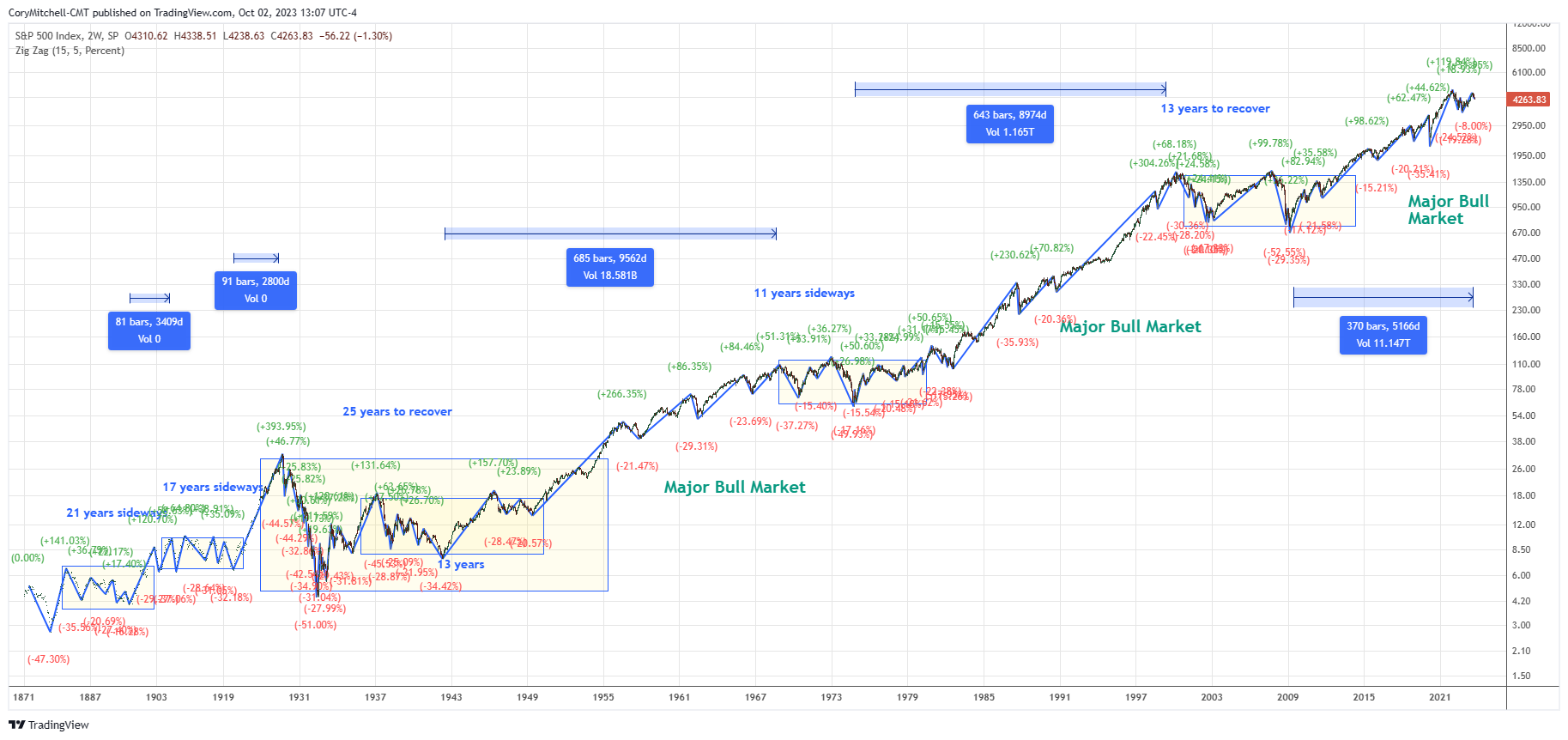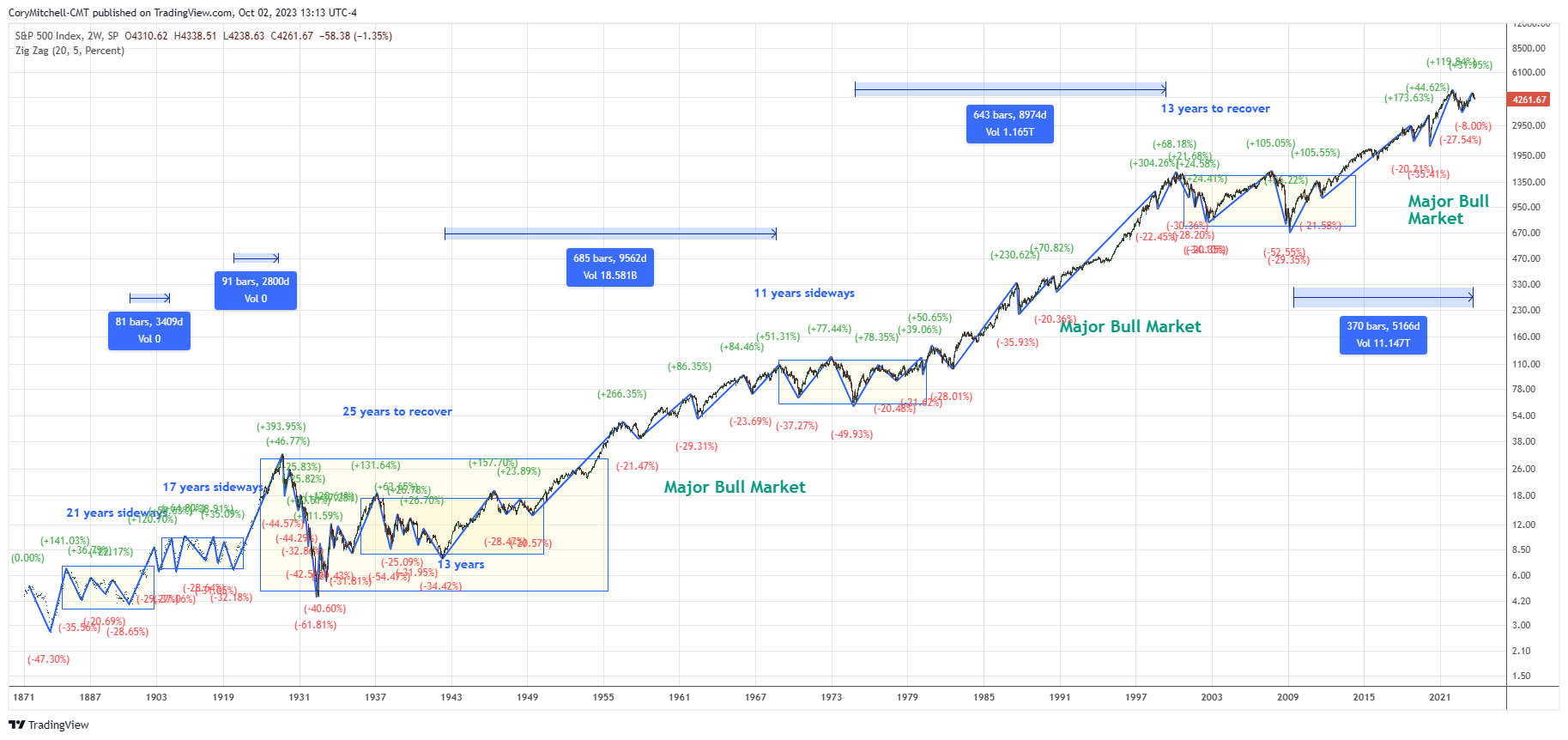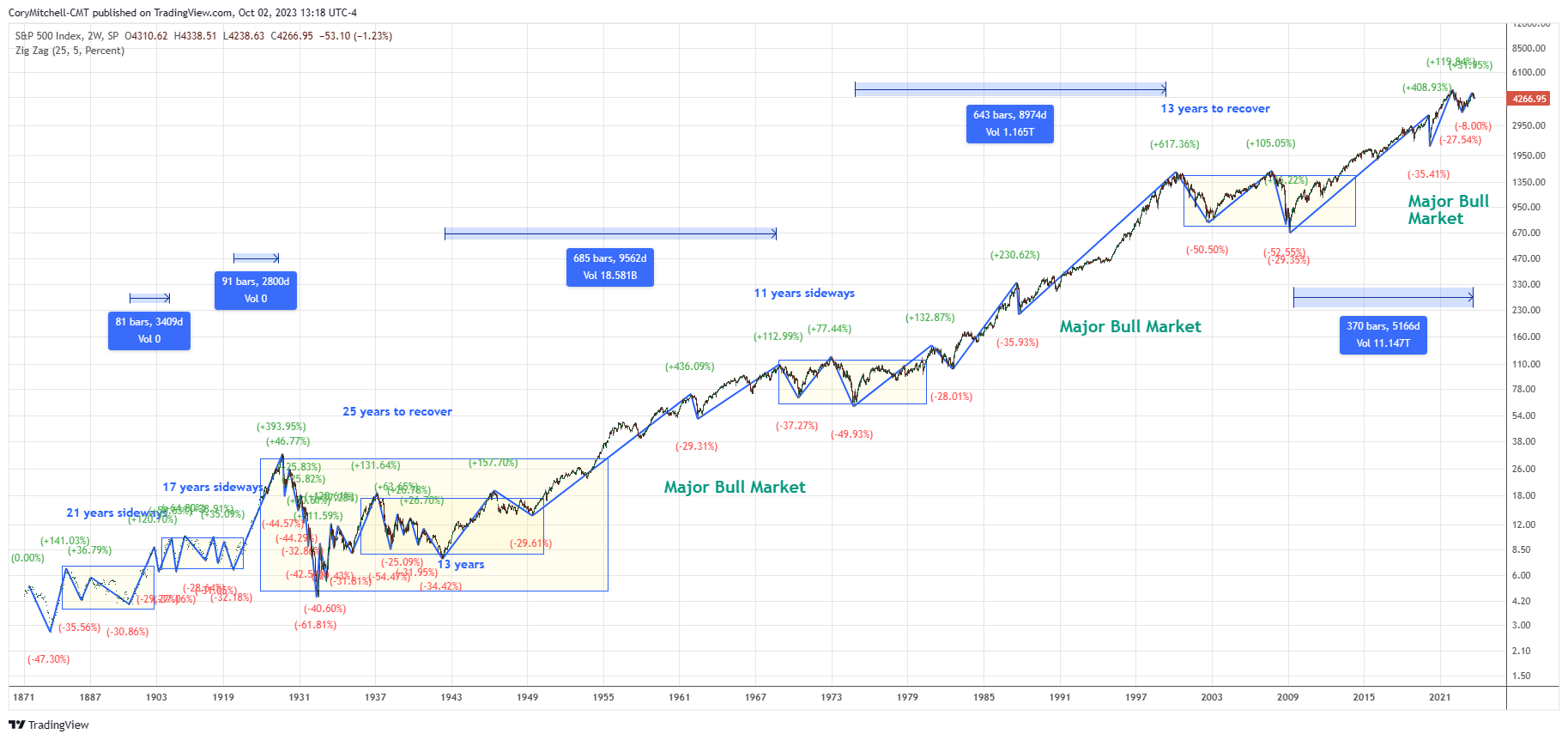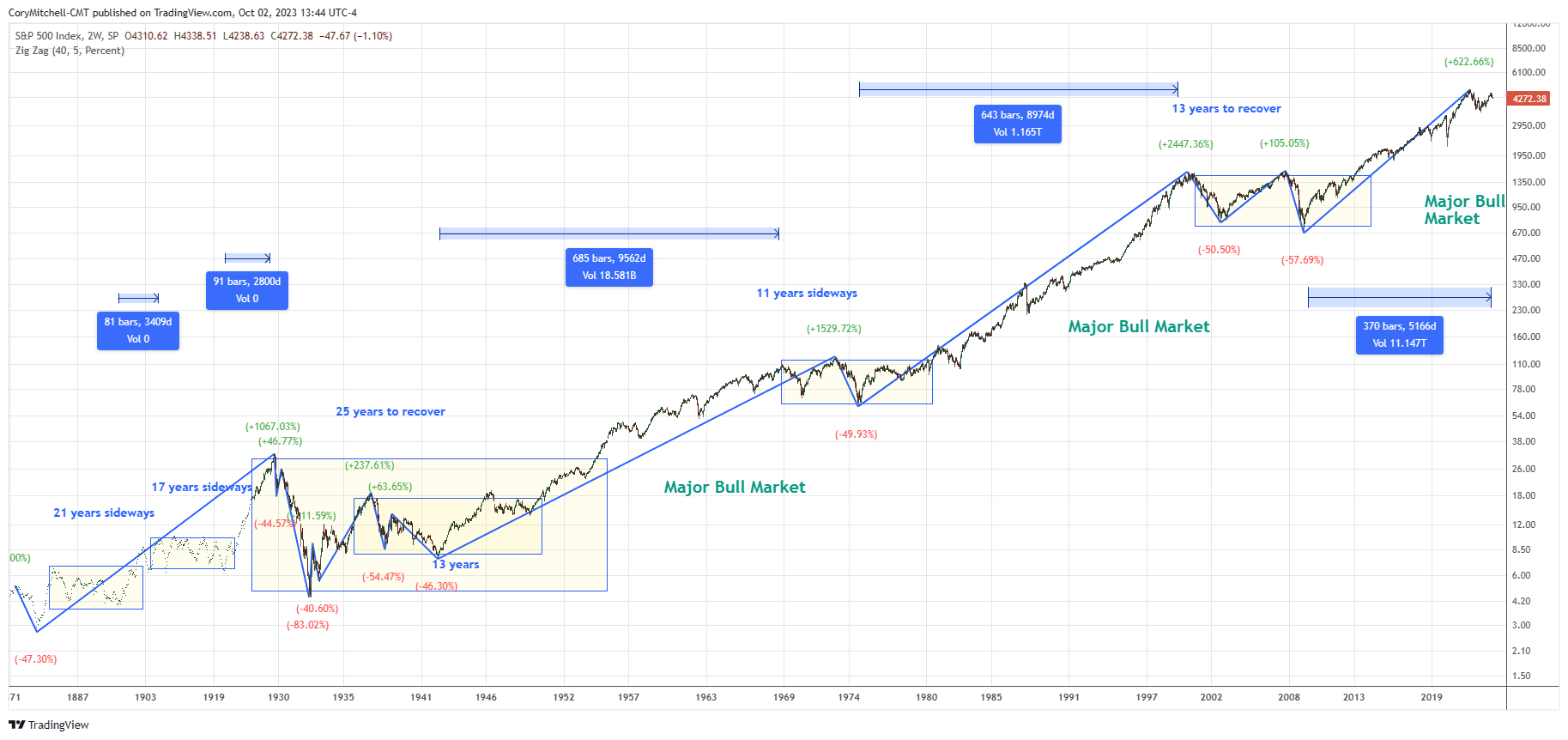A History Of Stock Market Percentage Declines (15% To 50%+), In Charts
When the stock market starts dropping 5% or 10% most people think it’s the start of the next big crash. Looking at history, we see that small declines are very common, and very large drops are quite rare.
This article shows all the very common declines of 15%, as well as the larger declines of 20%, 25%, 30%, 40%, and 50% or more, so you can see how often these types of events occur, and can thus prepare yourself.
The charts below are based on the S&P 500 index and its predecessors, which means dividends received from holding an index-related ETF or stocks are not included. Including dividends would reduce/offset the severity of the declines and also add to the long-term returns or rally percentages.
The yearly average return of the S&P 500, including dividends, is 10.5% over the last 100 years, including all the ups and downs you’ll see below.
These charts pertain to the S&P 500, which is a diversified index holding quality companies. These charts don’t relate to declines in individual stocks.
How Common Are 15% Declines in the Stock Market?
15% drops in a major index like the S&P 500 are quite common. Expect one to two 15% or more declines in most five-year periods.
The following chart shows all the 15% drops (following at least a 15% rally) going back to the late 1800s.
(Click on image to enlarge)

The blue line on the chart that marks all the ups and downs is called Zig Zag. It filters out prices moves less than a certain size. In order for a new Zig Zag line to form, a move in the opposite direction of the size specified must occur. If it doesn’t, the current line continues. On this chart, it marks all price moves of 15% or more.
How Common Are 20% Declines in the Stock Market?
20% drops in the S&P 500 are still common. Expect one to two within a five year period. That said, most 20% declines are great long-term buying opportunities because there are relatively a small number of 20% declines that drop beyond 30% (but it does happen). So most 20% declines are a good time to buy high-quality companies or low-cost index ETFs.
Including only 20% declines cleans up the chart a little bit, but there are still lots of these types of declines.
(Click on image to enlarge)

How Common Are 25% Declines in the Stock Market?
If you look at the chart above, you’ll notice many of the declines are 22%, 24%, etc. Once a decline reaches 25% in the S&P 500, that is becoming more rare. Only including 25% or larger declines cleans up the chart considerably. This is why the prior section indicated that buying near 20% declines is often a prudent strategy for long-term investors since many of those 20% declines don’t end up exceeding 25%. But of course, some do, and those are the ones shown on this chart.
Expect a 25% decline (or more) in the S&P 500 every 5 to 15 years.
(Click on image to enlarge)

How Common Are 30% Declines in the Stock Market?
A 30% drop, or greater, in the S&P 500 is a big deal. There have only been 6 declines bigger than that since the 1950s. These types of declines were more common pre-1950.
Since the 1950s, the market has moved in a trend-consolidation-trend cycle. The market ran higher into the late 1960s, then consolidated with two large drops within five years.
It then began another trend phase with one 30% drop before the next consolidation phase which started in 2000. During that consolidation phase, there were two large drops within 8 years. The next trend phase started and it was more than a decade before the next 30% drop.
In the past, the stock market has trended for more than 25 years without a 30% (or greater) drop. At other times large declines have been clustered together, but are still quite rare and thus present good long-term investment opportunities.
(Click on image to enlarge)

How Common Are 40% Declines in the Stock Market?
While it seems that many people think the market will crash 50% everytime there is a 10% decline, hopefully you’re seeing this isn’t the case. 40% declines are extremely rare. There have only been three such declines since the early 1940s.
The 50% decline in 1974 was followed by a rally of 2447% before the next 40% decline.
The 51% decline of 2000-2002 was followed by a 105% rally before the next 58% decline in 2008. The market has rallied 622% since that time (not including dividends) with no 40% decline as of yet.
(Click on image to enlarge)

How Common Are 50% Declines in the Stock Market?
Going back to 1871, there have only been 4 declines of 50% or more. The most severe was the 1930s crash where stock values fell nearly 90%. The other 3 declines of 50% or more did not exceed 60%.
(Click on image to enlarge)

How Long It Takes to Recover After a Stock Market Crash
Declines of 30% or more can see prices rally back quite quickly, but it can sometimes take years for the price to move past a prior high point.
It took the stock market 25 years to get back to the high point seen before the great crash of the 1930s.
During the 70s the market moved sideways for a decade, even though prices bounced back after each drop within a few years.
The 2000 crash took nearly 6 years to recover, and then another crash occurred again. It took about 6 years once again to return to the high point before the 2008 crash.
This is why I like passive investing in index ETFs (buy and hold until for next 20 years). Making regular contributions each month, whether prices go up or down, means that recovery time is cut in half and takes advantage of the long-term returns of the S&P 500 and other indices like the Nasdaq 100 (which is more volatile).
In my more active investing (trades lasting one year or more), I hunt for quality companies and will buy them during market declines, ideally once indices have turned higher and have positive Health Indicators. This approach benefits from the recovery after a decline. I don’t hold these stocks through major declines (I determine how and why I will exit before the trade), but I do hold my long-term passive investment ETFs through the ups and downs, continually adding to the position.
Final Word on Stock Market Decline Percentages
5% to 10% declines are super common. You’ll see one or more of these declines in an average year.
15% declines are still very common, but 25% declines are much less common.
30%, 40%, and 50% declines are progressively less common but do still occur. Most 20% declines are a good buying opportunity, because there are a lot of them, but relatively few of them go on to become 25% or greater declines.
The data shows that some of those declines will keep going, and turn into a crash of larger magnitude.
Before investing, formulate a strategy around what you are willing to hold through. Consider your risk tolerance and whether you are a buy-and-hold investor or are willing to trade in and out of the market based on conditions.
More By This Author:
EUR/USD Day Trading Charts And Trades For August
Historical Average Returns For Nasdaq 100 Index
Best Performing US ETFs Of The Last 1, 3, 5, And 10 Years
Disclaimer: Nothing in this article is personal investment advice, or advice to buy or sell anything. Trading is risky and can result in substantial losses, even more than deposited if using ...
more


